Abstract
Sera from patients with endocarditis and bacteremia due to Staphylococcus aureus were compared for peptidoglycan-binding capacity with those from normal blood donors. Those patients treated with beta-lactam antibiotics had higher antigen-binding levels than normal donors and patients treated exclusively with vancomycin (P less than 0.01). The factor responsible for this activity was purified by affinity chromatography from a normal donor and shown to be an immunoglobulin. Specificity studies indicated that the immunodominant determinant was a peptide sequence found in peptidoglycan precursors. Since soluble peptidoglycan molecules having the precursor peptide sequence are known to be secreted by some gram-positive bacteria like Micrococcus luteus when grown in the presence of beta-lactam antibiotics, these soluble molecules may constitute the "natural" immunogen. Such a hypothesis is consistent with the study of the peptidoglycan-binding capacities in the sera of these patients during the course of treatment. For most of the responding patients studied (four of four with bacteremia and seven of nine with endocarditis), a significant increase in peptidoglycan-binding capacity was observed in sera taken 1 to 5 weeks after the initiation of beta-lactam antibiotic therapy (compared with the initial serum studied). No such increase in the peptidoglycan-binding capacity over a similar time span was noted in the sera of people not receiving beta-lactam antibiotics (none of seven).
Full text
PDF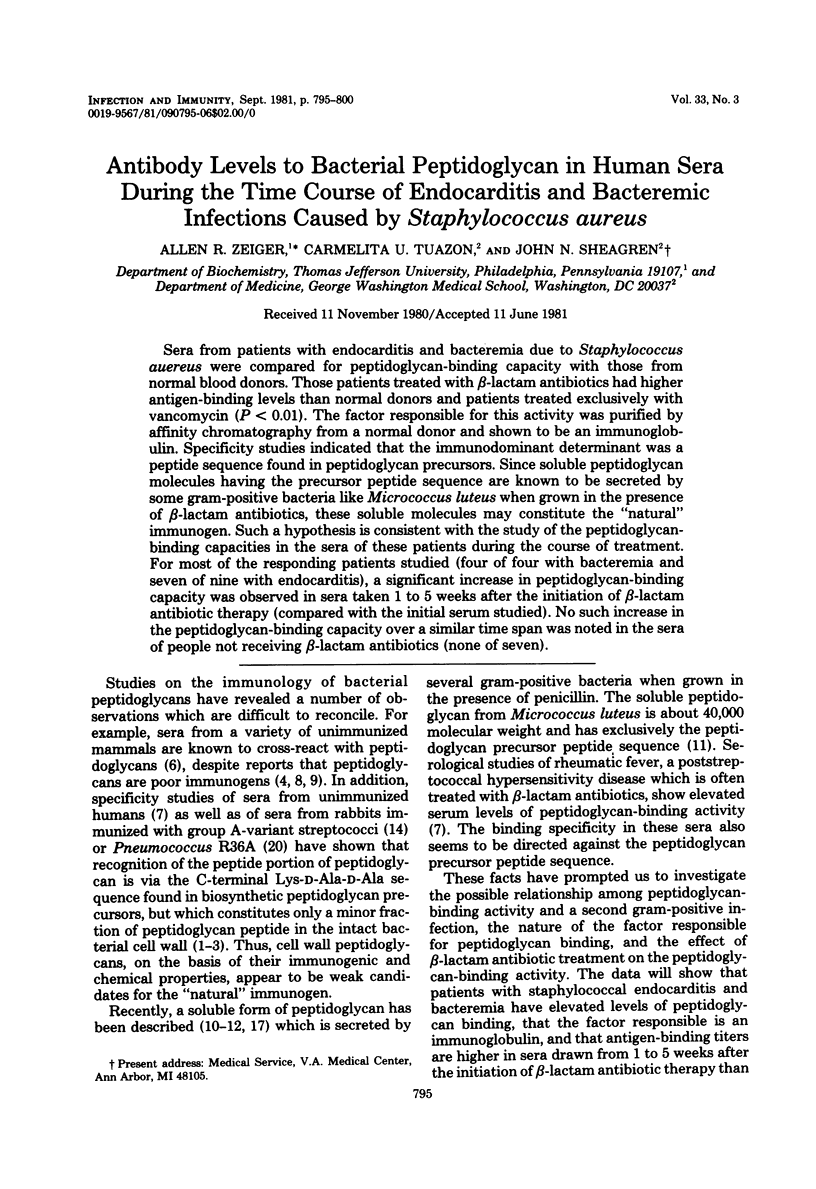
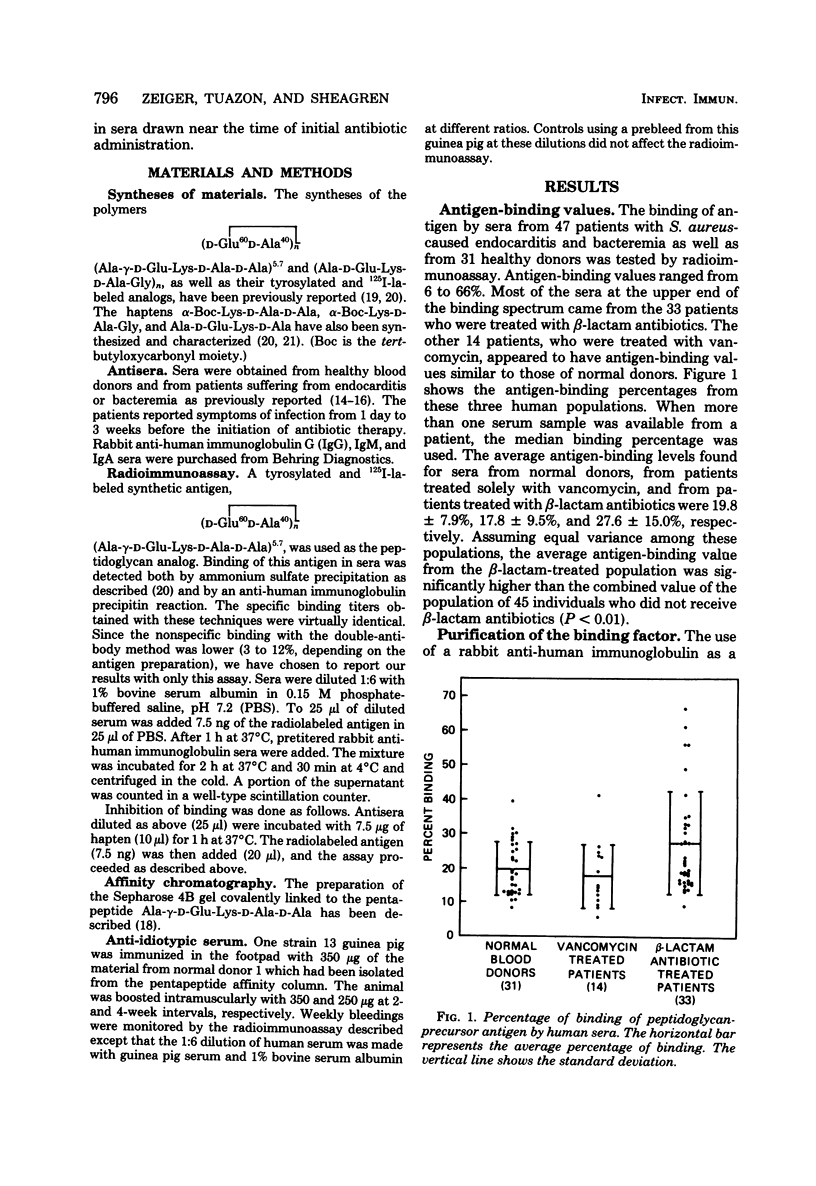
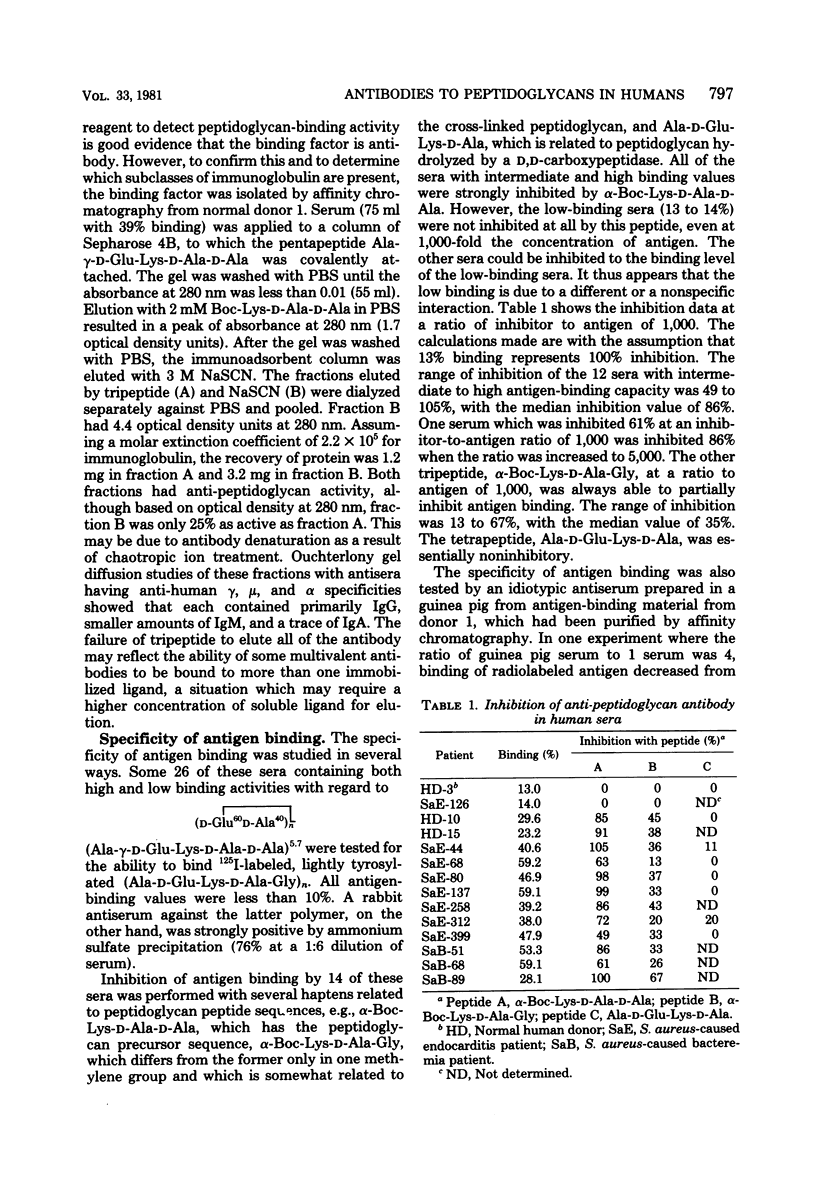
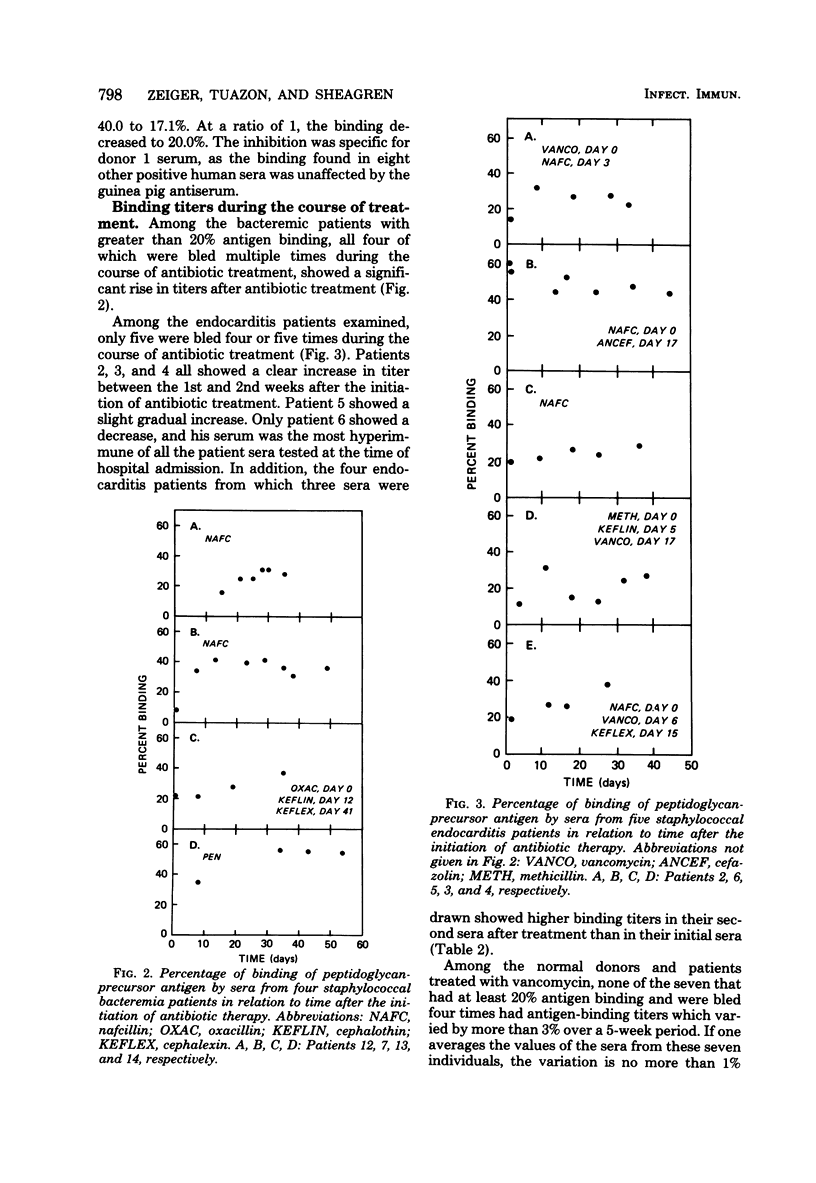
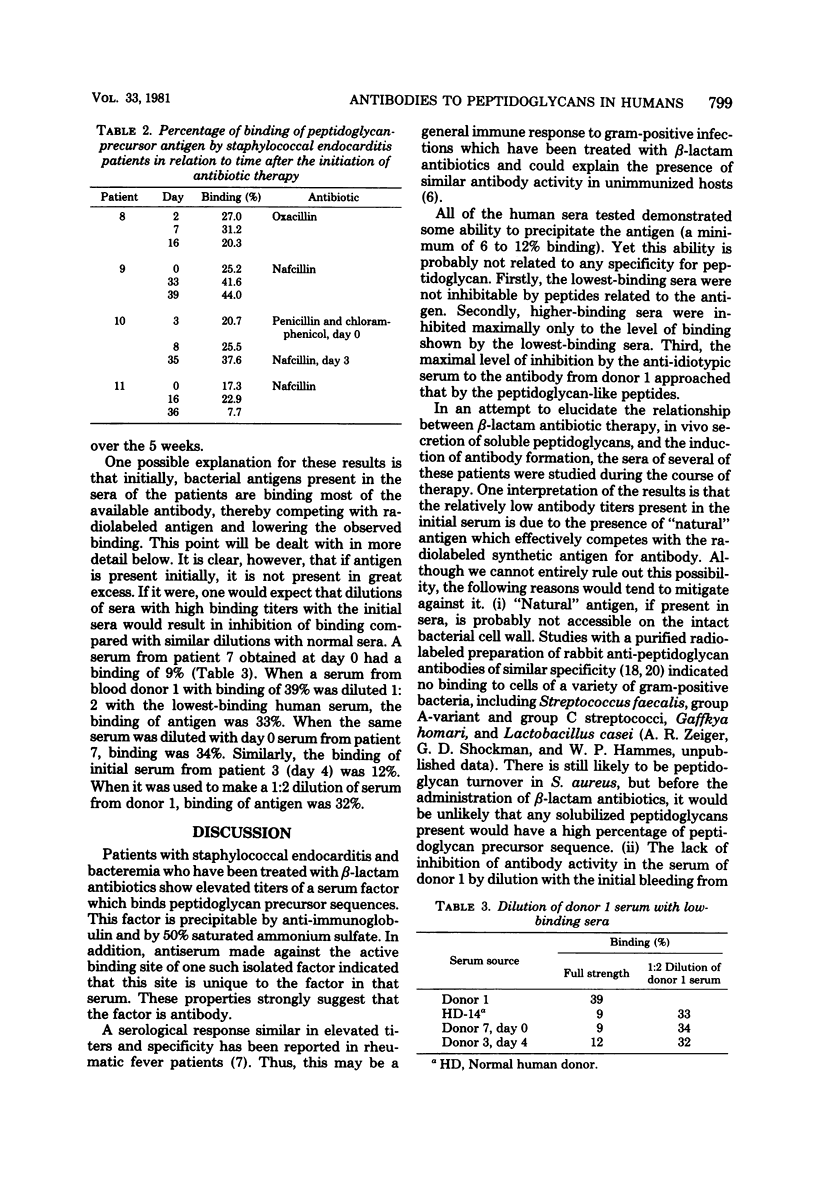
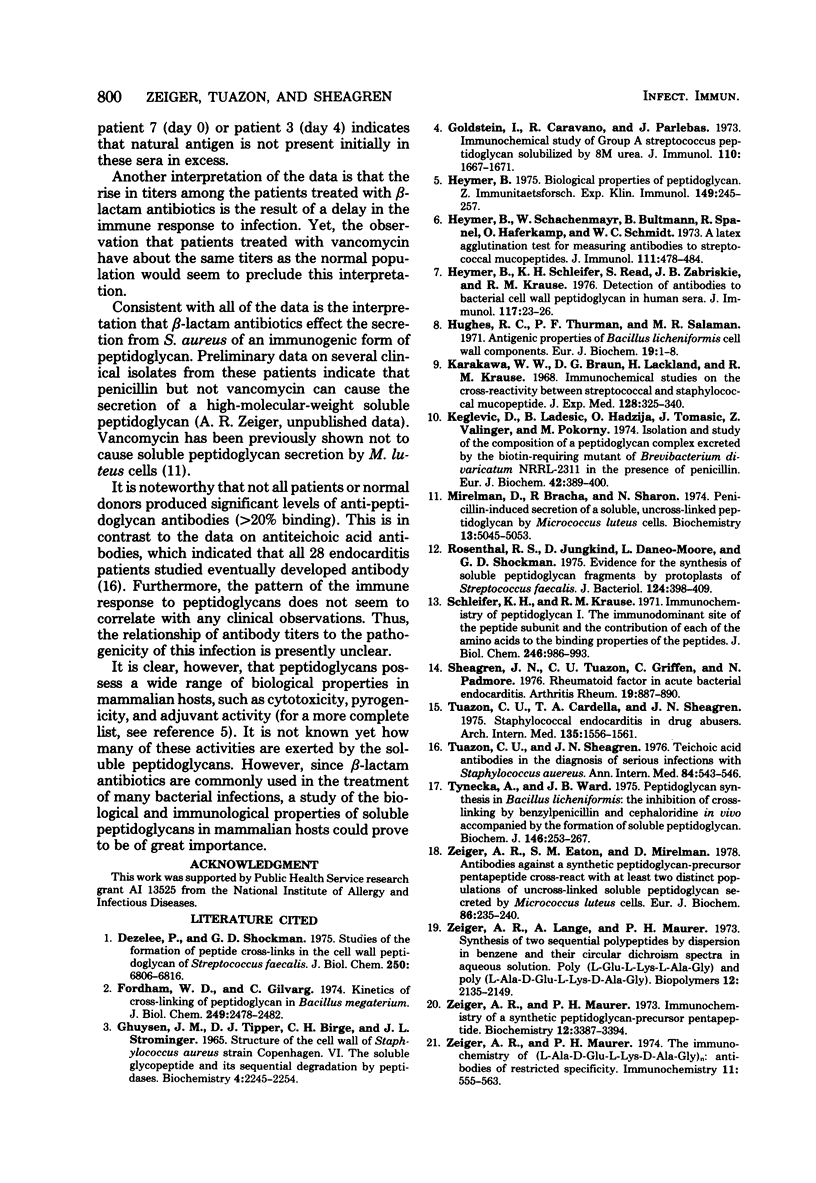
Selected References
These references are in PubMed. This may not be the complete list of references from this article.
- Dezélée P., Shockman G. D. Studies of the formation of peptide cross-links in the cell wall peptidoglycan of Streptococcus faecalis. J Biol Chem. 1975 Sep 10;250(17):6806–6816. [PubMed] [Google Scholar]
- Fordham W. D., Gilvarg C. Kinetics of cross-linking of peptidoglycan in Bacillus megaterium. J Biol Chem. 1974 Apr 25;249(8):2478–2482. [PubMed] [Google Scholar]
- Goldstein I., Caravano R., Parlebas J. Immunochemical study of group A streptococcus peptidoglycan solubilized by 8M urea. J Immunol. 1973 Jun;110(6):1667–1671. [PubMed] [Google Scholar]
- Heymer B. Biological properties of the peptidoglycan. Z Immunitatsforsch Exp Klin Immunol. 1975 Jul;149(2-4):245–257. [PubMed] [Google Scholar]
- Heymer B., Schachenmayr W., Bültmann B., Spanel R., Hafferkamp O., Schmidt W. C. A latex agglutination test for measuring antibodies to Streptococcal mucopeptides. J Immunol. 1973 Aug;111(2):478–484. [PubMed] [Google Scholar]
- Heymer B., Schleifer K. H., Read S., Zabriskie J. B., Krause R. M. Detection of antibodies to bacterial cell wall peptidoglycan in human sera. J Immunol. 1976 Jul;117(1):23–26. [PubMed] [Google Scholar]
- Hughes R. C., Thurman P. F., Salaman M. R. Antigenic properties of Bacillus licheniformis cell wall components. Eur J Biochem. 1971 Mar 1;19(1):1–8. doi: 10.1111/j.1432-1033.1971.tb01281.x. [DOI] [PubMed] [Google Scholar]
- Karakawa W. W., Braun D. G., Lackland H., Krause R. M. Immunochemical studies on the cross-reactivity between streptococcal and staphylococcal mucopeptide. J Exp Med. 1968 Aug 1;128(2):325–340. doi: 10.1084/jem.128.2.325. [DOI] [PMC free article] [PubMed] [Google Scholar]
- Keglević D., Ladesić B., Hadzija O., Tomasić J., Valinger Z., Pokorny M., Naumski R. Isolation and study of the composition of a peptidoglycan complex excreted by the biotin-requiring mutant of Brevibacterium divaricatum NRRL-2311 in the presence of penicillin. Eur J Biochem. 1974 Mar 1;42(2):389–400. doi: 10.1111/j.1432-1033.1974.tb03351.x. [DOI] [PubMed] [Google Scholar]
- Mirelman D., Bracha R., Sharon N. Penicillin-induced secretion of soluble, uncross-linked peptidoglycan by Micrococcus luteus cells. Biochemistry. 1974 Nov 19;13(24):5045–5053. doi: 10.1021/bi00721a028. [DOI] [PubMed] [Google Scholar]
- Rosenthal R. S., Jungkind D., Daneo-Moore L., Shockman G. D. Evidence for the synthesis of soluble peptidoglycan fragments by protoplasts of Streptococcus faecalis. J Bacteriol. 1975 Oct;124(1):398–409. doi: 10.1128/jb.124.1.398-409.1975. [DOI] [PMC free article] [PubMed] [Google Scholar]
- Schleifer K. H., Krause R. M. The immunochemistry of peptidoglycan. I. The immunodominant site of the peptide subunit and the contribution of each of the amino acids to the binding properties of the peptides. J Biol Chem. 1971 Feb 25;246(4):986–993. [PubMed] [Google Scholar]
- Sheagren J. N., Tuazon C. U., Griffin C., Padmore N. Rheumatoid factor in acute bacterial endocarditis. Arthritis Rheum. 1976 Sep-Oct;19(5):887–890. doi: 10.1002/art.1780190509. [DOI] [PubMed] [Google Scholar]
- Tuazon C. U., Cardella T. A., Sheagren J. N. Staphylococcal endocarditis in drug users. Clinical and microbiologic aspects. Arch Intern Med. 1975 Dec;135(12):1555–1561. [PubMed] [Google Scholar]
- Tuazon C. U., Sheagren J. N. Teichoic acid antibodies in the diagnosis of serious infections with Staphylococcus aureus. Ann Intern Med. 1976 May;84(5):543–546. doi: 10.7326/0003-4819-84-5-543. [DOI] [PubMed] [Google Scholar]
- Tynecka Z., Ward J. B. Peptidoglycan synthesis in Bacillus licheniformis. The inhibition of cross-linking by benzylpenicillin and cephaloridine in vivo accompanied by the formation of soluble peptidoglycan. Biochem J. 1975 Jan;146(1):253–267. doi: 10.1042/bj1460253. [DOI] [PMC free article] [PubMed] [Google Scholar]
- Zeiger A. R., Eaton S. M., Mirelman D. Antibodies against a synthetic peptidoglycan-precursor pentapeptide cross-react with at least two distinct populations of uncross-linked soluble peptidoglycan secreted by Micrococcus luteus cells. Eur J Biochem. 1978 May;86(1):235–240. doi: 10.1111/j.1432-1033.1978.tb12304.x. [DOI] [PubMed] [Google Scholar]
- Zeiger A. R., Lange A., Maurer P. H. Synthesis of two sequential polypeptides by dispersion in benzene and their circular dichroism spectra in aqueous solution: Poly(L-glu-L-lys-L-ala-gly) and poly(L-ala-D-glu-L-lys-D-ala-gly). Biopolymers. 1973;12(9):2135–2149. doi: 10.1002/bip.1973.360120917. [DOI] [PubMed] [Google Scholar]
- Zeiger A. R., Maurer P. H. Immunochemistry of a synthetic peptidoglycan-precursor pentapeptide. Biochemistry. 1973 Aug 28;12(18):3387–3394. doi: 10.1021/bi00742a004. [DOI] [PubMed] [Google Scholar]
- Zeiger A. R., Maurer P. H. The immunochemistry of (L-Ala-D-Glu-L-Lys-D-Ala-Gly)n: antibodies of restricted specificity. Immunochemistry. 1974 Sep;11(9):555–563. doi: 10.1016/0019-2791(74)90247-x. [DOI] [PubMed] [Google Scholar]


